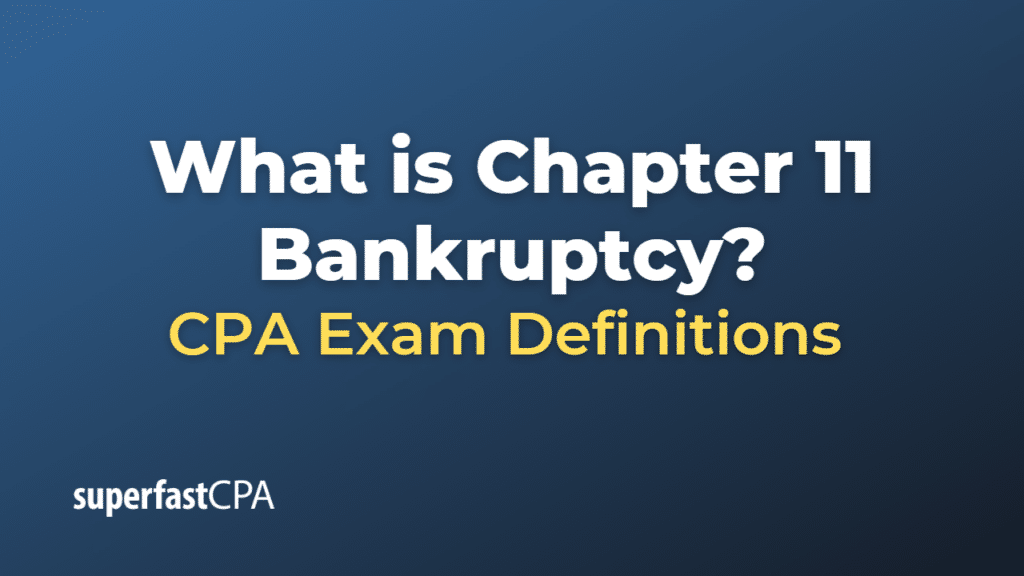Chapter 11 Bankruptcy
Chapter 11 bankruptcy is a legal process in the United States that allows businesses and, in some cases, individuals to reorganize their debts and financial affairs under the protection of the bankruptcy court. It is primarily used by businesses facing financial distress but still have the potential to become viable again. The primary goal of Chapter 11 bankruptcy is to help the debtor restructure its debts, operations, and business model, enabling it to continue operating while paying off its obligations over time.
Under Chapter 11 bankruptcy, the debtor usually remains in control of its assets and continues to operate the business as a “debtor in possession.” The debtor is required to submit a reorganization plan to the bankruptcy court, detailing how it intends to restructure its debts, renegotiate contracts, and streamline its operations. The plan must be approved by the court and the creditors, who often have the right to vote on the proposal.
Some key aspects of Chapter 11 bankruptcy include:
- Automatic stay: Once a debtor files for Chapter 11 bankruptcy, an automatic stay is put in place, which temporarily halts all collection efforts, lawsuits, and other actions by creditors to recover their debts. This provides the debtor with breathing room to develop and negotiate its reorganization plan.
- Reorganization plan: The debtor has to develop a comprehensive plan outlining how it will address its debts, renegotiate contracts, and make necessary operational changes. This plan must be approved by the court and, in most cases, the creditors.
- Creditor committees: In some Chapter 11 cases, a committee of unsecured creditors may be appointed to represent the interests of all unsecured creditors, negotiate with the debtor, and participate in the development and approval of the reorganization plan.
- Debt discharge: If the reorganization plan is successfully implemented, some of the debtor’s remaining debts may be discharged, allowing the business to emerge from bankruptcy with a reduced debt burden and a more sustainable financial position.
Chapter 11 bankruptcy can be a complex, time-consuming, and expensive process. However, it offers businesses in financial distress an opportunity to restructure their operations, renegotiate their debts, and ultimately, continue operating while working towards regaining financial stability.
Example of Chapter 11 Bankruptcy
Let’s consider a hypothetical example of a company filing for Chapter 11 bankruptcy:
ABC Manufacturing is a company that produces industrial equipment. Over the past few years, the company has faced a decline in sales due to increased competition, outdated technology, and high operational costs. As a result, ABC Manufacturing has accumulated a significant amount of debt that it is unable to repay.
Recognizing that the company still has the potential to become viable if it can restructure its debts and operations, ABC Manufacturing decides to file for Chapter 11 bankruptcy protection.
- Automatic stay: Upon filing for Chapter 11 bankruptcy, an automatic stay is put in place, temporarily halting all collection efforts, lawsuits, and other actions by creditors to recover their debts. This gives ABC Manufacturing some breathing room to develop its reorganization plan.
- Reorganization plan: ABC Manufacturing works with its financial and legal advisors to develop a comprehensive reorganization plan. The plan includes proposals to renegotiate its debts, reduce operational costs by closing some of its less profitable plants, invest in updated technology, and focus on more profitable product lines. The plan is submitted to the bankruptcy court and the creditors for approval.
- Creditor committees: A committee of unsecured creditors is formed to represent the interests of all unsecured creditors. The committee negotiates with ABC Manufacturing, reviews the reorganization plan, and participates in the approval process.
- Plan confirmation and implementation: The reorganization plan is approved by the bankruptcy court and the creditors. ABC Manufacturing begins implementing the plan, renegotiating its debts, making operational changes, and working towards regaining financial stability.
- Debt discharge and emergence from bankruptcy: After successfully implementing the reorganization plan, some of ABC Manufacturing’s remaining debts may be discharged. The company emerges from Chapter 11 bankruptcy with a reduced debt burden, a more efficient operational structure, and a stronger financial position.
In this example, Chapter 11 bankruptcy allowed ABC Manufacturing to restructure its debts and operations, providing it with an opportunity to recover from financial distress and continue operating as a viable business.













